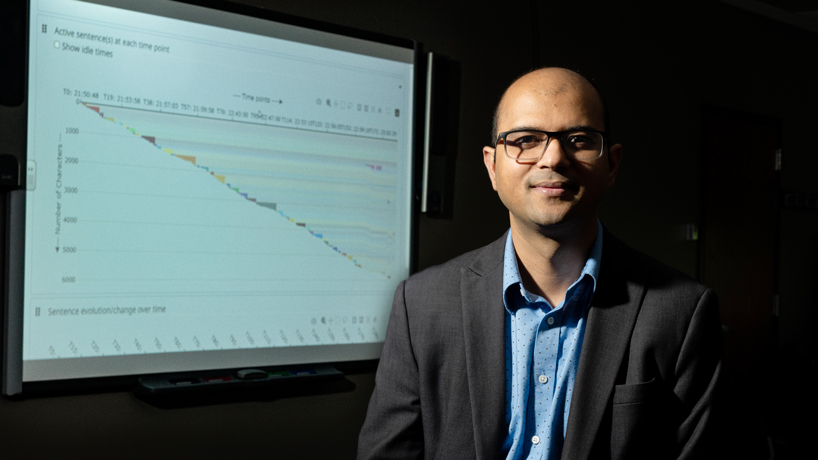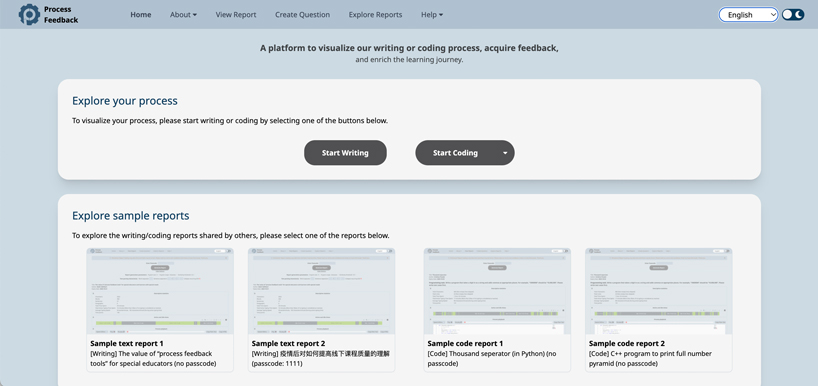
Badri Adhikari, an assistant professor of computer science, developed a new online tool called Process Feedback that provides writers and coders visualizations to help them better understand their own writing process. (Photo by Derik Holtmann)
The world is waiting to see exactly how revolutionary artificial intelligence-powered chatbots such as ChatGPT or BARD can be at simplifying or taking over tasks in day-to-day life, but it seems clear the changes to come are going to place an even greater importance on people’s ability to think critically and clearly.
One of the best ways to sharpen those skills is by learning how to write and revise, whether it’s sentences in an essay or lines of code in a program.
A new free online tool is designed to help people gain a deeper understanding of their writing or coding process and the thinking that takes place throughout it. Process Feedback, a tool developed by Badri Adhikari, an assistant professor in the Department of Computer Science at the University of Missouri–St. Louis, captures the work of a writer or coder as they are in the process of producing it and can provide them with analysis in charts and graphs to help them better visualize and understand how they went about performing the work and any patterns that exist.
The home page of Process Feedback, a new online tool developed by UMSL Assistant Professor Badri Adhikari, provides users a choice to use the tool for writing or coding, can be set to any of nine languages and provides samples of the types of analysis it provides writers and coders about their work process. (Screenshot)
The tool is ready to be tested by educators and students at any institution for any course, and they will soon have it ready to integrate with any learning management system, such as Canvas or Blackboard.
“Educational research has shown that during learning, the process is at least as important as the outcomes,” Adhikari said. “Learning to think through the process, make mistakes, incorporate feedback and make corrections all helps learners grow and develop innate creative abilities.”
Looking at the visualizations created with Process Feedback can help students gain insight into the way they write at a time when metacognition is so important, and the tool can also help their teachers better model the writing or coding process for their students, going beyond the finished work to show them the time spent writing, deleting and revising.
“Because writing is a multidimensional process, it is complex to teach,” said Shea Kerkhoff, an assistant professor specializing in literacy and secondary education in UMSL’s College of Education, who has demoed the tool. “We know that feedback is crucial to helping people grow as writers. Process Feedback holds a lot of promise as a teaching and learning tool for writing.”
It could be that showing students data on the time teachers spend writing and revising their work – and the amount of text that might be written and then deleted during that process – can help the students understand how much writing and rewriting they need to do to perfect their own work.
Similarly, in a coding context, teachers can use Process Feedback to show how much code needs to be written and improved before it works as intended.
Educators also can have their students use the tool to gain a better understanding of where students seem confident and where they might be struggling in their writing process. They can then tailor their teaching to address those areas.
“Educators are very passionate and wonderful teachers who want to help these students learn,” Adhikari said. “The problem is they just don’t know where the students are struggling, particularly in writing. I imagine one very important use case would be during the evaluation process. Educators can have students with learning differences sit down and use this tool for half an hour, 45 minutes, let them write, and then once they are done, they can go back and look at where the students stuck most of the time. What did he do well? When was he fluent? When did he take breaks? They can then write appropriate goals for these students.”
Adhikari even imagines a potential use for Process Feedback alongside ChatGPT and BARD. A teacher might challenge their students to edit and improve a document or piece of code created by the chatbot. They can then use the tool to examine how the students went about making those revisions.
Process Feedback is a highly accessible but privacy-focused web application. There is no login or password required, but the application does not track or enforce data collection from its users. They are free to use the tool in the way that they want.
It currently can be used to analyze writing and coding in nine languages, including English, French, Nepali, Hindi, Arabic and Vietnamese.
Adhikari, an expert in deep learning, developed Process Feedback in concert with several of his UMSL students and teaching assistants as well as Chief Technology Officer Jason Wagstaff and a group of developers from his native Nepal.
He has written a full manuscript about Process Feedback, and it is currently under review by a peer-reviewed journal.















